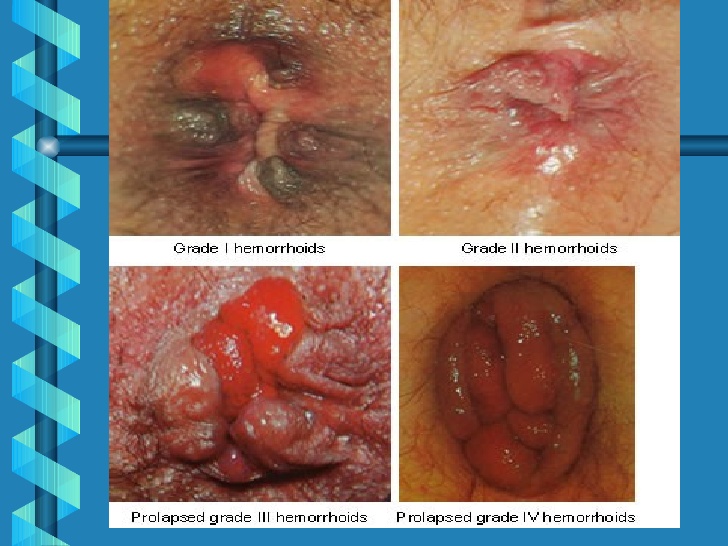TYPES OF PILES

TYPES OF PILES
WHAT ARE THE DIFFERENT TYPES OF PILES (HAEMORRHOIDS)?
Internal piles (haemorrhoids) are those that form above a point 2-3 cm inside the back passage (anus) in the upper part of the anal canal. Internal piles are usually painless because the upper anal canal has no pain nerve fibres. External piles are those that form below that point, in the lower part of the anal canal. External piles may be painful because the lower part of the anal canal has lots of pain nerve fibres.
The terminology can be a little confusing - you would have thought that external piles would mean outside of the anal canal (and so outside of the anus) but this is not always the case. There are external piles that are actually inside the anus. Internal piles can also enlarge and drop down (prolapse), so that they hang outside of the anus.
Some people develop internal and external piles at the same time.
Internal piles can be classified into grades 1 to 4 according to their severity and size:
-
Grade 1
are small swellings on the inside lining of the anal canal. They cannot be seen or felt from outside the anus. Grade 1 piles are common. In some people they enlarge further to grade 2 or more. -
Grade 2
are larger. They may be partly pushed out from the anus when you go to the toilet, but quickly spring back inside again. -
Grade 3
hang out from the anus when you go to the toilet. You may feel one or more as small, soft lumps that hang from the anus. However, you can push them back inside the anus with a finger. -
Grade 4
permanently hang down from within the anus, and you cannot push them back inside. They sometimes become quite large.
Stages of Hemorrhoids
For convenience in describing the severity of internal hemorrhoids, many physicians use a grading system:
-
Second-degree hemorrhoids:
Hemorrhoids that prolapse and retract on their own (with or without bleeding). -
Third-degree hemorrhoids:
Hemorrhoids that prolapse but must be pushed back in by a finger. -
Fourth-degree hemorrhoids:
Hemorrhoids that prolapse and cannot be pushed back in the anal canal. Fourth-degree hemorrhoids also include hemorrhoids that are thrombosed (containing blood clots) or that pull much of the lining of the rectum through the anus.
WHAT CAUSES PILES (HEMORRHOIDS)?
The exact reason why the changes in the veins within the lining of the anal canal occur and lead to piles (haemorrhoids) forming is not clear. Some piles seem to develop for no apparent reason. However, it is thought that an increased pressure in and around the back passage (anus) and anal canal can be a major factor in many cases.
About half the people in the UK develop one or more piles at some stage. Certain situations increase the chance of piles developing:
-
Constipation,
passing large stools (faeces), and straining at the toilet. These increase the pressure in and around the veins in the anus and seem to be a common reason for piles to develop. -
Pregnancy.
Piles are common during pregnancy. This is probably due to pressure effects of the baby lying above the rectum and anus, and the affect that the change in hormones during pregnancy can have on the veins. -
Ageing.
The tissues in the lining of the anus may become less supportive as we get older. -
Hereditary factors.
Some people may inherit a weakness of the wall of the veins in the anal region.
WHAT ARE THE SYMPTOMS OF PILES (HEMORRHOIDS)?
If you think that you may have piles (haemorrhoids), or have bleeding or pain from your back passage (anus), you should visit your doctor.
Piles are usually diagnosed after your doctor asks you questions about your symptoms and performs a physical examination. The examination usually includes an examination of your back passage. Wearing gloves and using a lubricant, your doctor will examine your back passage with their finger to look for any signs of piles or other abnormalities.
Sometimes, if your piles are not obvious after an examination of your back passage, your doctor may suggest a further examination called a proctoscopy. This is where the inside of your back passage is examined using an instrument called a proctoscope. A proctoscope is a short, hollow tube that has a light at one end and allows the doctor to see the lining of your back passage, and any piles, more clearly.
In some cases, a more detailed examination of your bowel may be needed to help rule out other conditions. Your doctor may refer you to a specialist for this.
Make an Appointment